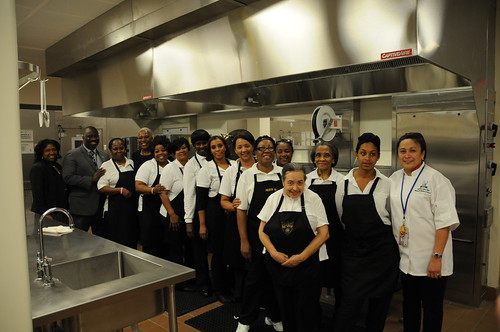Last week, USDA celebrated National School Lunch Week from October 12 -18 with exciting local events across the country. It was a chance for USDA staff to meet with students and hear what they think of the newer, fresher options in the lunch room. It was also an opportunity for USDA officials to say “thank you” to the hardworking school food service professionals who make healthy school lunches possible.
Healthy meals at school are an essential part of every child’s health, development, and academic success. Students’ ability to learn in the classroom, grow up healthy and reach their fullest potential depends on the environment they learn in. And that is why Congress passed the Healthy, Hunger-Free Kids Act, so that all our nation’s students can experience a healthier school environment with more nutritious options.
Here are a couple highlights from the week:
Under Secretary Kevin Concannon, center, watches on as a student takes a bite of his apple at Casimir Pulaski Elementary School in Meriden, Conn., Oct. 17, during National School Lunch Week. This is the first school in the state of Connecticut to be awarded with the HealthierUS School Challenge (Gold Award of Distinction), which recognizes schools that have created healthier school environments through promotion of nutrition and physical activity.

Robin Bailey Jr., Southeast Regional Administrator at the USDA’s Food and Nutrition Service, thanks school nutrition professionals and tells 5th graders at Ford Elementary School in Cobb County, GA how important nutritious breakfasts and lunches are to peak performance at school and in life.

FNS Administrator Audrey Rowe visits Oxon Hill High School in Maryland to celebrate National School Lunch Week. Here, Rowe takes the time to thank the school's Food Service Professionals for all their hard work and dedication.

Virginia Hunger Solutions and USDA staff celebrated Richmond City Public Schools becoming one of the first in Virginia to implement the Community Eligibility Provision (CEP) district-wide, providing school breakfast and lunch to all students at no charge this school year.

USDA staff celebrates National School Lunch Week with students in Carmel-Clay, Ind. Thanks to the new standards, we are seeing students eating up to 16 percent more vegetables and up to 23 percent more fruit at lunch. We know that 44 percent of schools participate in the Farm to School Program, which brings fresh and local foods into school cafeterias. Additionally, independent research indicates that students who eat school breakfast achieve 17.5 percent higher test scores and miss 1.5 less days of school.

The USDA’s Food and Nutrition Service will continue to work with schools, parents, teachers, food service professionals and local farmers to ensure that the healthy choice is the easy choice for our nation’s students.
